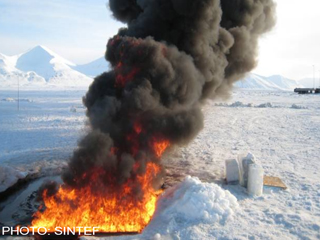In-Situ Burning

In-situ burning is the term given to the process of burning floating oil at sea, at or close to the site of a spill. In order to undertake burning, the oil must be concentrated and an ignition source applied. Burning oil at seas has, in ideal conditions, the potential to remove relatively large amounts of oil from the sea surface.
The decision whether or not to burn oil at sea is often complex. The resultant fire and potentially toxic smoke has the potential to impact human health and therefore it is a technique more suitable for use offshore or away from populated areas. In Arctic regions, concern has been expressed about the potential impact of soot deposits on the rate of melting ice. The condition of the oil is also important; as the oil weathers it may lose its lighter oil fractions through evaporation and the oil may start to form an emulsion. Both these processes will make the oil more difficult to ignite and burn. Given the many factors to consider, the decision-making process for in-situ burning is best addressed during the contingency planning process.
For a successful in-situ burn the layer of oil on the sea surface needs to be at least 2-3mm thick to counter the cooling effect of the wind and sea and maintain a fuel source to the fire. Spreading of the slick means that the oil may need to be contained against a barrier. This can occur naturally against ice sheets or the shoreline, or by corralling it using fire resistant booms or 'herder chemicals.
Ignition can be achieved using a variety of devices ranging from a diesel-soaked rag to more sophisticated equipment, such as the Helitorch. This is essentially a flame-thrower which is suspended beneath a helicopter and is generally accepted as being one of the safest methods of ignition in trained hands. However, the device and experience to use it are not readily available in many parts of the world.
The state of the sea can limit the success of any burn and choppy seas may extinguish the fire altogether. Once alight, the slick itself needs to reach sufficiently high temperatures to keep the fire burning. However, as the slick becomes thinner due to the removal of the lighter fractions, the cooling effect of the wind and sea will eventually extinguish the fire.
The viscous residue that can be left following in-situ burning resembles the consistency of toffee, and can be difficult to recover. Residues also have the potential to sink and therefore may smother or be toxic to bottom dwelling (benthic) marine species. There is also the potential that residues might contaminate fishing gear.
